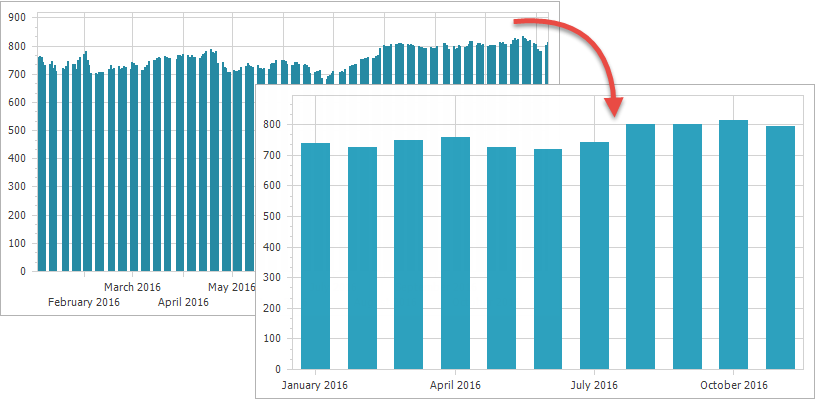DateTimeScaleOptions.MeasureUnit Property
Gets or sets the detail level for date-time values.
Namespace: DevExpress.XtraCharts
Assembly: DevExpress.XtraCharts.v25.2.dll
NuGet Package: DevExpress.Charts
Declaration
Property Value
| Type | Description |
|---|---|
| DateTimeMeasureUnit | A DateTimeMeasureUnit enumeration value which represents the axis’ detail level. |
Available values:
| Name | Description |
|---|---|
| Millisecond | Specifies a millisecond as the measurement unit for date-time values. |
| Second | Specifies a second as the measurement unit for date-time values. |
| Minute | Specifies a minute as the measurement unit for date-time values. |
| Hour | Specifies an hour as the measurement unit for date-time values. |
| Day | Specifies a day as the measurement unit for date-time values. |
| Week | Specifies a week as the measurement unit for date-time values. |
| Month | Specifies a month as the measurement unit for date-time values. |
| Quarter | Specifies a quarter of a year as the measurement unit for date-time values. |
| Year | Specifies a year as the measurement unit for date-time values. |
Property Paths
You can access this nested property as listed below:
| Object Type | Path to MeasureUnit |
|---|---|
| AxisBase |
|
Remarks
This property is available when the SeriesBase.ArgumentScaleType or SeriesBase.ValueScaleType property is set to DateTime, and the ScaleOptionsBase.ScaleMode property is set to Manual.
| DateTimeScaleOptions.MeasureUnit = Quarter | DateTimeScaleOptions.MeasureUnit = Year |
|---|---|
 |
 |
Note
To access DateTimeScaleOptions, use the AxisBase.DateTimeScaleOptions property.
To define a date-time measurement unit to which the beginning of a diagram’s gridlines and labels should be aligned, use the DateTimeScaleOptions.GridAlignment property.
Example
This example shows how to use DateTimeScaleOptions to reduce the number of visible series points.

The following code configures the axis scale settings to resemble to the chart appearance above:
DateTimeScaleOptions dateTimeScaleOptions = ((XYDiagram)chartControl.Diagram).AxisX.DateTimeScaleOptions;
dateTimeScaleOptions.WorkdaysOnly = true;
dateTimeScaleOptions.ScaleMode = ScaleMode.Manual;
dateTimeScaleOptions.AggregateFunction = AggregateFunction.Average;
dateTimeScaleOptions.MeasureUnit = DateTimeMeasureUnit.Month;
dateTimeScaleOptions.GridAlignment = DateTimeGridAlignment.Quarter;
dateTimeScaleOptions.GridSpacing = 1;
The following table lists the API members the code above uses:
| Member | Description |
|---|---|
| AxisBase.DateTimeScaleOptions | Stores the options that define the behavior of a scale when its type is date-time. |
| ScaleOptionsBase.ScaleMode | Gets or sets the scale mode for an axis. |
| ScaleMode | Lists the values that specify the scale mode for an axis. |
DateTimeScaleOptions.MeasureUnit |
Gets or sets the detail level for date-time values. |
| DateTimeMeasureUnit | Lists the values that specify the detail level for date-time values. |
| ScaleGridOptionsBase.GridOffset | Gets or sets the offset of grid lines and major tickmarks. |
| ScaleGridOptionsBase.AggregateFunction | Gets or sets the value indicating the aggregate function that should be used to relieve data. |
| AggregateFunction | Lists the values that specify the aggregate function used for an axis. |
| DateTimeScaleOptions.GridAlignment | Gets or sets the date-time measure unit to which the beginning of an axis’ gridlines and labels should be aligned. |
| DateTimeGridAlignment | Lists the values that specify the date-time measurement unit, to which the beginning of a diagram’s gridlines and labels should be aligned. |
| ScaleGridOptionsBase.GridSpacing | Gets or sets the interval between grid lines and major tickmarks. |
Related GitHub Examples
The following code snippets (auto-collected from DevExpress Examples) contain references to the MeasureUnit property.
Note
The algorithm used to collect these code examples remains a work in progress. Accordingly, the links and snippets below may produce inaccurate results. If you encounter an issue with code examples below, please use the feedback form on this page to report the issue.